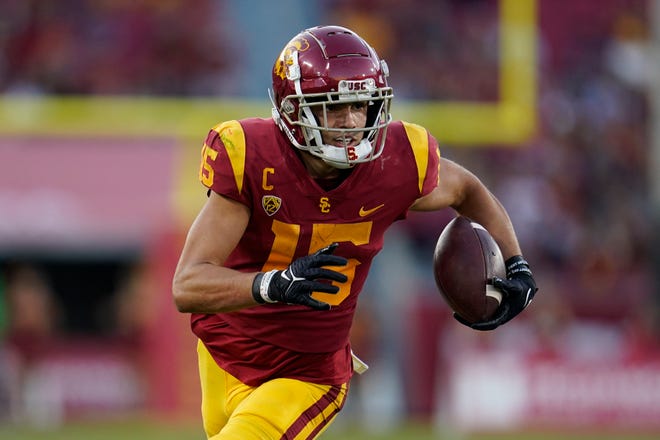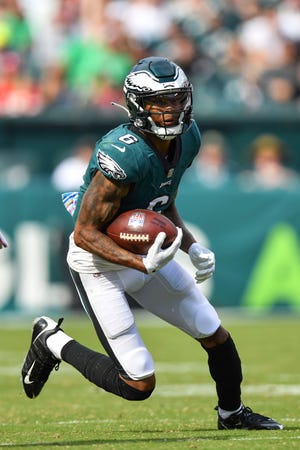Perhaps the Eagles’ decision to draft a wide receiver in the first two rounds was finalized on March 18, the day Christian Kirk signed a four-year deal with the Jacksonville Jaguars worth an average of $18 million per season.
Kirk was certainly someone the Eagles sought, a slot receiver who had 982 yards receiving last season for the Arizona Cardinals.
But the Jaguars outbid everyone to get Kirk, who never had as much as 1,000 yards receiving. The Jaguars were flush with salary cap space and were desperate to provide weapons for quarterback Trevor Lawrence, the No. 1 overall pick in the 2021 draft.
STICKING WITH HURTS:What Josh Allen, Carson Wentz and QBs in draft have to do with Eagles backing Jalen Hurts
REAGOR REDUX:This draft is crucial for Eagles, so why is Howie Roseman still haunted by Jalen Reagor?
That was only the beginning of a veritable explosion in wide receiver salaries.
At around the same time as Kirk’s deal, Chris Godwin, recovering from a torn ACL, and Mike Williams stayed with their current teams for an average of $20 million per season. In the weeks that followed, Davante Adams and Tyreek Hill were traded and signed new contracts averaging even more.
Allen Robinson, JuJu Smith-Schuster and Marquez Valdes-Scantling, among others, also signed lucrative contracts.
The Eagles, meanwhile, sat on the sidelines. They were reportedly interested in trading for Atlanta’s Calvin Ridley, but he was suspended for the coming season for betting on NFL games.
They had free agent money to spend, but used much of it on pass rusher Haason Reddick. They could have restructured some current salaries to possibly top the Jaguars’ offer for Kirk, or tried to trade for Hill or Adams.
Instead, they gave slot receiver Zach Pascal a one-year deal for $1.5 million that can be worth as much as $2.5 million if he hits all the incentives.
“It’s like the new mining town, right?” Eagles general manager Howie Roseman said when asked about the “boom” in contracts for wide receivers. “You have to make a decision on what your priorities are on building the team, or whether you’re going to kind of go with the flow … or if there’s some value in being different and figuring out what now is kind of the next area.”
If the Eagles, who have two first-round picks at No. 15 and No. 18, are going to improve their wide receiver unit, it will likely happen early in the three-day draft that begins Thursday.
They could draft a wide receiver in the first round for the third straight year, something only the Detroit Lions (2003-05) have done in NFL history.
If they do, they could pick from among Ohio State’s Chris Olave, USC’s Drake London or Alabama’s Jameson Williams, who’s recovering from a torn ACL but is considered the best receiver in the draft.

It’s expected that Ohio State’s Garrett Wilson will be taken before the Eagles pick.
NFL Network draft analyst Daniel Jeremiah said he expects six wide receivers to be drafted in the first round. And if recent history is any indication, most of them will play – and produce – right away.
The Eagles took advantage of this last year when they picked DeVonta Smith at No. 10 overall. Smith was the Eagles’ best wide receiver from the moment he arrived. Smith’s first NFL catch, in the season opener, was for a touchdown, and he finished with 916 yards receiving, setting a team rookie record.
But in 2020, they drafted Jalen Reagor in the first round, No. 21 overall. He has 695 yards receiving in two disappointing seasons. As of now, he seems to be the fourth wide receiver behind Smith, Quez Watkins and Pascal.
They also have J.J. Arcega-Whiteside, taken in the second round in 2019. Arcega-Whiteside, with 16 receptions in three seasons, is reportedly moving to tight end, most likely as a last-ditch effort to keep his spot on the team.
But the Eagles will keep trying because the chances of hitting on a wide receiver early in the draft are much greater than in the past, and it’s much more cost-effective than a free agent.
The top three from last year in Smith, Miami’s Jaylen Waddle (104 catches) and the Bengals’ Ja’Marr Chase are already stars. Chase set the rookie record for receiving yards in a season with 1,455.
Chase broke the record set the year before by Justin Jefferson, the Vikings’ first-round pick in 2021. Jefferson is the first wide receiver in NFL history with at least 3,000 receiving yards in his first two seasons.
There are several star wide receivers drafted in 2020 and 2019, too, such as Jefferson, Dallas’ CeeDee Lamb, Seattle’s D.K. Metcalf and Washington’s Terry McLaurin.
Most importantly, all of them are on their rookie contracts, meaning they are millions of dollars cheaper than a marquee free agent.
“You look at somebody like Justin Jefferson, who obviously is a great example (considering) where he was picked in the draft,” Jeremiah said. “His average (salary) is like $3 million a year. So you get cost control on a player like that, at that price, for four years, plus a fifth-year option (for a first-rounder) versus having to go the veteran route and paying that huge, huge number to get a premium guy.”
Of course, the Eagles are in this position of needing a wide receiver because they missed with Arcega-Whiteside, who went seven spots ahead of Metcalf and one round before Washington took McLaurin.
The Eagles also missed with Reagor at 21, while Jefferson went to the Vikings with the very next pick. Lamb (1,102 yards in 2021) went at No. 17, Brandon Aiyuk (856 yards) went 25th, and Tee Higgins (1,091 yards) went in the second round.
Missing on Reagor is still a much better outcome for the Eagles than what happened with the Giants, who signed Kenny Golladay to a four-year deal worth as much as $72 million. Golladay had 37 receptions last season, Reagor had 31.

Golladay has a $21 million salary cap hit in 2022, while Reagor’s cap hit is $3.6 million.
NFL draft analysts credit the rapid development of wide receivers from a young age for their readiness to play right away in the NFL.
“Every high school in the country, just about, is running a spread offense, and they’re throwing it all over the place,” Jeremiah said. “These kids are playing 7-on-7 year-round. They’re going to colleges where they play with four and five wideouts so they get on the field early. They get a lot of experience. They catch a lot of footballs.”
The results speak for themselves.
In 2020 and 2021, the Bengals drafted Higgins, Chase and quarterback Joe Burrow. They improved from 4-11-1 in 2020 and went to the Super Bowl last season.
During that time, the Eagles drafted Reagor, quarterback Jalen Hurts and Smith. They improved from 4-11-1 in 2020 and made the playoffs last season, losing in the first round to the Buccaneers.
By having those skill position players on rookie contracts, the Bengals were able to sign a pass rusher in free agency last winter in Trey Hendrickson, who had 14 sacks in 2021. The Eagles went that route by signing Reddick.
“I think it’s interesting that the receiver market continues to explode when it seems like every year we have a good wide receiver class coming into the draft,” said Mark Dominik, a longtime NFL scout and former general manager of the Tampa Bay Buccaneers, and now a Sirius XM commentator.
Kirk is proof of that.
Contact Martin Frank at mfrank@delawareonline.com. Follow on Twitter @Mfranknfl.